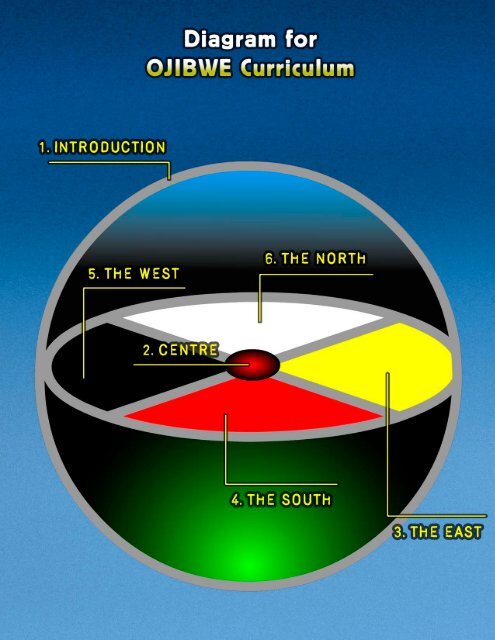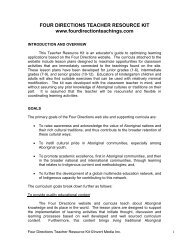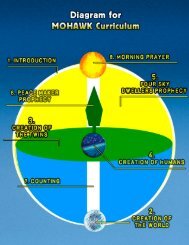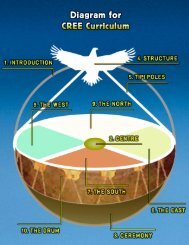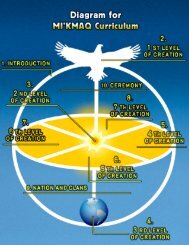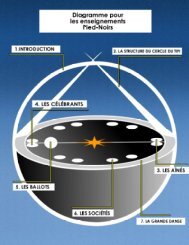OJIBWE/ POWAWATOMI (ANISHINABE) TEACHING - Four Directions
OJIBWE/ POWAWATOMI (ANISHINABE) TEACHING - Four Directions
OJIBWE/ POWAWATOMI (ANISHINABE) TEACHING - Four Directions
- No tags were found...
Create successful ePaper yourself
Turn your PDF publications into a flip-book with our unique Google optimized e-Paper software.
<strong>OJIBWE</strong>/ <strong>POWAWATOMI</strong> (<strong>ANISHINABE</strong>) <strong>TEACHING</strong>ELDER: LILLIAN PITAWANAKWATINTRODUCTIONBoozhoo. 1 Welcome to this sacred knowledge that’s been gifted to us, to all thetwo-legged that walk on Mother Earth.These teachings that are being shared are sacred teachings. From tribe to tribe,the details may differ but the basic teachings are the same. They have beenfollowed and shared for many, many years. So we honour the ancestors, theones that have walked before us, because they’re the ones that sat in circlesmany times before, and prayed that their children and their grandchildren wouldfollow in their path. When we honour the ancestors, we honour ourselves.There are Seven Sacred <strong>Directions</strong>.The <strong>Four</strong> Cardinal points on the Medicine Wheel are the <strong>Four</strong> Sacred <strong>Directions</strong>,represented among the Ojibwe by the colours yellow, red, black and white. Bluerepresents Father Sky in the upper realm, Green represents Mother Earth below,and purple represents the self, that spirit that journeys in this physical world, atthe centre of the wheel.The Seven Stages of Life are also found on this Medicine Wheel. They begin inthe east and move across the Wheel to the West. The Seven Stages of Life are:The Good Life, The Fast Life, The Wandering Life, the stages of Truth, Planning,and Doing, and The Elder Life.The Seven Grandfather Teachings are also located on this Medicine Wheel.They begin in the Northern direction and move down to the centre of the Wheel.These gifts are the teachings of Honesty, Humility, Courage, Wisdom, Respect,Generosity and Love.The Teachings of the Medicine Wheel are vast. There are seven teachingswithin each direction on the Ojibwe wheel, and all these have sub-teachings tothem, such as where all the medicines like sweetgrass came from, and what theymean.The four directions of the Medicine Wheel remind us of many things, such as theneed for balance in the world, and the balance we must strive for everyday within1 Glossary note: “Boozhoo” is a greeting in Ojibwe.© 2006 All Rights Reserved 4D Interactive Inc.
ourselves. Here you will begin to get an idea of a few of those many teachingsand connections that are in the circle. Everything comes in fours, so it’s easier todigest, easier to learn. The four direction teachings go clockwise, beginning inthe east. But before we travel around the wheel, let’s look at the Centre.CENTREEach of us carries a fire within. Whether it’s through the knowledge we have, orthrough our experiences and associations, we are responsible for maintainingthat fire. And so as a child, when my mother and father would say, at the end ofthe day - My daughter, how is your fire burning?” It would make me think of whatI’ve gone through that day -- If I’d been offensive to anyone, or if they haveoffended me. I would reflect on that because it has a lot to do with nurturing thefire within. And so we were taught at a very early age to let go of any distractionsof the day by making peace within ourselves, so that we can nurture andmaintain our fire.We have many teachings on the value of nurturance. When I was a child myfather told us about the Rose Story. He said the Creator asked the flowerpeople, “Who among you will bring a reminder to the two-legged about theessence of life?” The buttercup answered, “I will, Creator, I will.” And theCreator said, “No, you can’t, because you’re too bright.” All of the flowers offeredtheir help. At the very end the rose said, “Let me remind them with my essence,so that in times of sadness, and in times of joy, they will remember how to bekind to themselves.”So the Creator, the Master Gardener, took a seed of the rose and planted it inMother Earth. The winds tilled the soil and the warm rains gave it water until avery small sprout came through the ground. Day after day it grew. The stemsprouted little thorns that were very, very sharp. After the thorns came the littleleaves. As time went on, a little bud formed. After much care this little budbloomed into a full rose.And so life is like a rose. The thorns are our life’s journey; without them wewould lack the hard won teachings that we need to in order to grow. Life’sexperiences make us who we are. And like the rose, we too decay and die manytimes in a life time only to come back to fruition again and again, after reflection,meditation, awareness, acceptance and surrender.My father told us the rose is both life and it’s gifts. So when I am making my ownMedicine Wheel, I put the rose here in the centre as a reminder of my own life’sjourney and it’s gifts.For this, I say “meegwetch.”© 2006 All Rights Reserved 4D Interactive Inc.
THE EAST – WAABINONGThe east is where we come from. It represents the springtime, and the spring oflife. It is where we begin our journey as human beings coming from the spiritworld into the physical world. This is Mother in here, the one that brings life.We are born when, as a spirit, we ask the Creator to go on this physical journey.The Creator grants us this request with four gifts: the gifts of picking our motherand father, so that they will help us come to an agreement, a balance, withinourselves, and the gift of picking and choosing how we are going to be born andhow we are going to die.And so in the spirit world, we find our spirit mother and our spirit father, and weask them, “will you be my vehicle to go to this physical world?” When they agree,Creator brings them together. A spirit is then born at the physical level, and iscarried by the woman for nine months until the water breaks. We then enter intothe physical world.Our journey begins here, when Creator breathes the spirit of life into us. And thespirit is the one that motivates all that life in this great circle. We are a spirit on aphysical journey, until our last breath.Life is a gift. To honour that gift we have been given tobacco.All life is spirit. It is the wind, the earth, the fire, the water, all of those things thatare alive with energy and movement. When we talk about life we are talkingabout spirit, and so we give thanks every day to those things that we cannot existwithout, because we need them on our journey.That is why we begin our day with the act of thanksgiving, by taking a little bit oftobacco and gently placing it in a clean place outside: in a garden, at the base ofa tree, or on the shore of a lake; a place where Mother Nature is unencumbered.When we do this we are giving thanks. We are humbling ourselves to creationand being grateful for the breath of life once more.Boozhoo Creator, Thank you. Thank you for giving me the breath of life. Thankyou for the world, for the life-giving Earth and for Grandfather Fire that warms mewhen I am cold. Thank you for the birds, and the crawlers, the swimmers, andthe trees. Thank you for the cycles of time: the fall, the winter, the spring andsummer. For all these things affect my being with their gift of Creation.© 2006 All Rights Reserved 4D Interactive Inc.
And so, we correlate Spirit with all that is called Nature, because it is life itself.When we follow natural law, it never lets us down, because natural law was theonly law that existed before man put himself on the road to progress.We have the gift of tobacco here in the eastern direction because it reminds us tobe grateful for all life – grateful in the way of being humble in knowing that we willalways require guidance and protection, and cannot exist without the gifts of thenatural world around us.There are many teachings that come from this eastern direction. I have shared asmall part of these with you, but in doing so I have accepted tobacco to honor therequest to share these teachings.I’ve been told ever since I was a young girl by my parents that when we hold ourtobacco in hand, when we ask the Creator for what we need, all our intentionsare answered. Not the way that we want them sometimes, but the way theCreator wants them.And so I honor this tobacco as I prepare myself to go on this journey with you.THE SOUTH – ZHAAWANONGHere in the southern direction of the Medicine Wheel, everything is thriving. Thetrees have come awake, producing their leaves. Life itself is awake and dancing,because the summer stage is here, a time of continued nurturance for all ofCreation, when everything is new and growing fast.Youth resides here in this direction. Youth are in the quandary stage - not oldenough to be an adult but no longer a child, when they are either searching forwhat they have left behind in their child stage, or losing that essence that ispresent within them, because of a lack of nurturance.The youth is searching for something and never finding it: searching forsomething that they used to have. “Who am I? Where do I come from?” As ayouth, we look to remember our humble beginnings as the child; we search forthat.The southern direction reminds us to look after our spirits. When you are inbalance within yourself, spirit will warn you of danger, will tell you, “No, don’t gothere. Go this way instead.” So no matter what happens, when you listen to thatspirit, to that intuition, it never deceives you. It’s always right, because that’syour guide. When that is disrupted, kids grow up without any direction, withoutany spirit nurturance. And they grow up to be teenagers, and they’re into allkinds of dangers and distractions. Why? It’s because there’s no spirit© 2006 All Rights Reserved 4D Interactive Inc.
foundation. Their spirits have not been nurtured. And their youth, theirwandering stage, becomes very distant.They have a long way to go before they catch up with themselves again, and thetruth about who they are. As a youth, I have to find people to help me in thattime of continued growth, so I hook up with like-minded people to give me thatnurturance that I think I need. And when our elders come in and say: “We havesomething for you; this is a gift I have for you; take a look at it; see what you thinkof it” - they’re not saying, “I want you to follow these teachings.” No. The eldersare inviting them; as an elder, I invite the youth to be a part of my journey. Andwith that invitation, most of the time, they join me, just to hear out what has life,what has meaning, what has purpose. And their lives begin to change. Theybegin to take accountability, to form a life style. They’re planning now to be abetter parent, to have a career, all of that. That becomes their truth.And so, looking at this life’s journey, how it used to be, and how it is today, wheredo we find the balance? We need to go back to our humble beginnings. Weneed to make contact with our ancestors, and say, “Please, have pity on me;pray that I will find my journey.”And so the youth reminds us to be mindful in our struggles, to remember ourhumble beginnings as the child, and to nurture the youth themselves, who aresearching, because they are still growing and in need of our guidance andprotection.That is why summer is the time of continued nurturance, where we learn tocultivate our spirits.The gift of cedar was given to help us in this direction.The Cedar Grandmother was asked by Creator, “Will you walk with these twoleggeds?Will you provide them with your medicine when they are hurting andwhen they are ill?”Our Grandmother agreed, and so to this day we honour that cedar tree, becauseshe is the Grandmother who comes to us free of charge to administer thatmedicine when we ingest her and drink of her sacred teas.And so we are reminded that spirit lives inside of us, and that to nurture spiritmeans we must be mindful of it, lest it should run away.Grandmother Cedar helps us; with her medicine she takes from us all thosethings that we don’t need on our journey. Once we’re ready to give them up, shetakes them from us and makes us anew. That is why cedar is considered acleansing medicine for body and soul.© 2006 All Rights Reserved 4D Interactive Inc.
THE WEST – EPANGISHMOKThe western direction is the adult stage, the berry stage. It is here that thegrowth from summer has come to ripen. It is the time of harvest, and so formuch of creation the physical journey is over, and that life crosses back into thespirit world.The sun setting in the west signifies the death of a day. And so we die manydeaths in a lifetime. And just as an old thought or feeling dies, and a new oneemerges, we die many deaths in a single day. So there is constant changewithin us. We dance around that western doorway many times in a day tohonour the death spirit.As we move through adulthood, death and loss become more and more visible.In the light of death, it is important that we accept that constant change is herewith us.The west also represents the heart, the evaluator of what’s going on in my life.As adults, we need to be in touch with this evaluator, because it helps us to seethe cycle of life, to appreciate and enjoy the fruits of life, and to accept aging andchange, making peace with our lives and deaths. We are given the responsibilityto nurture our hearts, so that we may be in balance, and see the Medicine Wheelfor what it is.And so to help us we have been gifted the medicine of sage. When we smudgeourselves, burn the sage and bring the smoke over our bodies, we are given thegift of clearing our minds and hearts, so that we may prepare well for the rest ofour journey.The Strawberry Teaching comes to mind here in the west, because it teachesforgiveness and peace. The Strawberry is shaped like a heart, and strawberriesare known to our people as heart berries. We were taught stories like these froma very early age.A long time ago, there was a family that chose to no longer live in their villagebecause of community feuding and ill will. This young family took their two littleboys and said, “Let us go back into the forest, and we’ll let the trees nurture ourchildren; we’ll let the birds sing songs to remind them of their own songs. Andwe’ll let the animals become their friends.” And so they packed up their littleboys and went deep into the forest.The father offered his tobacco, and asked the tree nation to give him a home. Hewas granted that gift and so he cut down the trees. He made a home for hisfamily and they moved in. The boys grew tall and strong, and yet year after yearthey continued to play fight and wrestle. Finally when they were in their teens,© 2006 All Rights Reserved 4D Interactive Inc.
their mother said to them, “It’s time for you to give up your childish ways.” Andthey said, “Okay mom, we won’t wrestle anymore.” But as soon as they were outof earshot from their mother, they said, “Let’s go deeper into the forest and we’llbuild a wrestling ring for ourselves, so we can go out there any time we feel likeit.” And so they did. They cleared some land and went there secretly, withouttheir mother’s knowledge.And then one fateful day the time came when the boys were wrestling and theolder brother knocked his younger brother to the ground, where he hit his headon a rock and died instantly. The oldest brother was beside himself. He said,“Please, please wake up… Mom and Dad are going to kill me. Please, pleaseanswer me.” The only answer was silence. He cried and begged his brother:“Please, please.” Finally after a couple of hours, a voice told him: “Bury yourbrother.” And so he dug into the ground and put his brother there. He coveredhim up and ran home.Out of breath, he ran to his parents: “Mom, Dad, I’ve lost my brother in the forest- I can’t find him.” And so the parents went out with him and they looked. Theycouldn’t find him anywhere. The father said, “I will go into the community, andseek out our relatives to come and help us form a search party so we can findhim.” So they searched for ten days, and ten nights, and then they went intomourning after they couldn’t find their son.But every day the brother would go to his little brother’s grave, and he would say,“Please, please tell me that you’re okay! Please!” And he would cry as hewalked away, because he had no answer. And years went by. He carried thissadness into his manhood because only he knew where his brother’s body lay.After many years and visits to his grave, the elder brother saw a tiny plant. Hewatched it grow into a little strawberry vine on top of his brother’s grave. Eachday he watched the leaves grow and the berries come into fruition.White heart-shaped berries appeared first. Then, over days, they transformedinto big red delicious berries, luscious and sweet. As he contemplated them, avoice from inside him said, “Take a berry and eat it.” So he picked a berry andhe put it in his mouth.As he ate it, he became aware, for the first time in his life, that he could taste thesweetness of life again. No more did he blame himself for his brother’s death,and no more did he blame his brother for not answering him. He no moreblamed his parents for their strict upbringing. And most of all, he no moreblamed the Creator for taking his brother’s life. He was free. After all of theselong years, he was finally free.And so here in the western direction we have learned something about death andabout the power of change and healing, and that finding peace doesn’t© 2006 All Rights Reserved 4D Interactive Inc.
necessarily come from the head – it comes from the heart. Death can be a placeof freedom: freedom to go on, freedom to be. It’s very important to rememberthat, because only then can we go on to enjoy the northern direction after wehave given careful consideration to these teachings in the west.THE NORTH – KIIWEDINONGNow it’s time to slow down from the business of birth and death, the continuum ofdeath and rebirth. Here in the Northern direction is the rest period. Some call itthe remembrance period, because after death, you rest, and you contemplatewhat has happened. But rest is also used here to be mindful of the physicalbody, to remember to care for and nurture our physical bodies: when they aretired, rest them, just as in the winter the Earth rests from her labours. When theyare hungry, feed them. And know what you are ingesting, what is good food forthe body.This is a time of reflection on being a child, a youth and an adult. And so it ishere that we honor our Elders. This is where they reside, along with the pipecarriers and the lodge keepers, because their ceremonies provide us withteachings of the whole Medicine Wheel, in all the directions. They also help usmake peace through embracing all those aspects of ourselves - the child, theyouth, and the adult - so that we may be able to feel and experience the fullnessof self.This is a place of wisdom.And so it is here during the winter months that the elders share their stories andteachings. In honour of this storytelling time, I too will share a story.Years ago we were prohibited from visiting Dreamer’s Rock. It is a sacred placein our territory where our people would go for vision quests. In 1968, that banwas lifted and we were able to go back and do our ceremonies. At this time Ibecame involved with the community because I believed in the value of ourteachings and ceremonies. But I had to first regain that fire.I will never forget it. In the first sweat lodge ceremony, the elder told us that thespirits that came into the lodge were hungry. He said, “I asked them what theyneeded and they said, “Bakademe – zhamzhenung.” This Elder was not of thesame dialect as me, but he brought those words from the sweat lodge. He said itmeans, “We are hungry; feed us.”Something inside of me stirred. I remembered as a child, my grandmother usedto say, “We will feed them, those that went ahead, our grandmothers, ourgrandfathers, all our relations.”© 2006 All Rights Reserved 4D Interactive Inc.
She would then prepare food and burn it on the stove, until the smoke from itpermeated the whole house. It was like the essence of their lives filled our homeand reminded us of how they contributed to our life’s journey. And that was agood feeling.I knew then, deep inside - Spirit spoke to me - I knew what I had to do.And so I went back home and called every household I knew. I said, “We’rehaving a celebration. Can you donate some food?” “Yes - yes, yes,” – everyoneagreed. People were awakening to something that they knew existed before.So we prepared the spirit plate. Every spoonful of food that was donated was puton that plate. And it was a heaping plate because there was so much food. Wetook that plate along with our tobacco to the fire and prayed: “Please hear us,”we said.“Grandfathers, grandmothers, ancestors, all our relations: please hear us. Weare here now, have pity on us. We had forgotten to feed you. You have lived along time without food, and now we are here to honour you. Please come andfeast with us.”As we put the food down, I could actually see those spirit hands grasping for thatfood because they were starving. It was at that moment that I began to crybecause I could feel my reconnection to this circle.And so as I share this story with you, I am sharing how I became reconnectedwith my ancestors. It is through them that we learn the sacred teachings thatthey carried. I cherish this story because it is not only about an awakening insideof me, but an awakening of a community that came together to celebrate a wayof being and spiritual nourishment. We still go back to our original teachings,because that’s where our food for life comes from, to nurture that spirit that isforever searching in life’s journey.And so I am grateful to all of my teachers and all of life’s teachings.This is what we learn from the four stages of the Medicine Wheel: that all of life’scycle is beautiful - the sadness and the joy, life and death; and that they are allone, and there is life in death, death in life - and that beauty itself resides withinthe balance of the whole circle.And so now we have come full circle, and I give thanks. To the EasternDoorway I say Meegwetch, to the Southern doorway, I say Meegwetch, to theWestern Doorway, Meegwetch, and to the Northern doorway, Meegwetch.© 2006 All Rights Reserved 4D Interactive Inc.
THE SEVEN STAGES OF LIFEThe Good LifeAfter birth, the first seven years of our lives is the good life. I’m going to presentthe ideal first, the way it used to be. And so the first seven years of a child’s life,there were elders, grandmothers, grandfathers that provide for all the needs ofthat child, unconditional love for that child, and discipline, and the child came toknow what life was all about, confident in who they were. And so the teachingsbegan very early in life. The support family was there - the mothers, the fathers,being supported by their mothers, their fathers, and the child became strong.And by the time they were seven years old, they were put out on their first dayfast to make them realize that these are all their relations that we walk with. Sothe child goes out to fast for a day, for a night, with all the support people.The Fast LifeAfter that, the child was prepared for the next leg of the journey, and that wascalled the fast life. This was when the child was being prepared for their four-dayvision quest at the time of puberty. And men were designated to look after theboys, women designated to look after the girls, to train them. So that after theirfasts they would be inducted into the men’s circle for the boys, and the women’scircle for the girls, so that there was always space for every individual. Nooutcasts in the circle. Everybody was included.The Wandering LifeThe next part was the wandering stage, where I go and wander about from placeto place to find my teachers, to find other experiences. The wandering phase.It’s also to wonder about life: “I wonder, if I did this, what would happen?” Sothere’s two wanders in there: w. a. n., and w. o.n. - the two wonders of life.TruthAnd so when we finish going through the wandering life, our elders, or ourteachers, our mentors that we picked out, are the ones that guided us to the nextphase, which was the Truth Stage - the truth being, taking a look at myself, that Ican see my mirror. These are my gifts. This is what I’ve learned from, and beingable to speak out of that truth of self.PlanningAnd then comes the planning stage. “What am I going to do with all of thisinformation that I have? How will I accomplish it?”© 2006 All Rights Reserved 4D Interactive Inc.
DoingAnd then after the planning stage comes the actual living out of it; practicing allthose things that I have learned on this life’s journey, to exactly where I’m at,there.ElderAnd then to be inducted into the elder’s circle. And all of those intervals, everyseven years, they would fast for direction and guidance. So then when theybecome elders, they come back and they teach the young ones. So there wasalways that circle of teaching. There were always professors there. Alwaysteaching, always sharing.And for every one of the Seven Stages of Life, it took about seven years - sevenyears to accomplish all of that.© 2006 All Rights Reserved 4D Interactive Inc.


